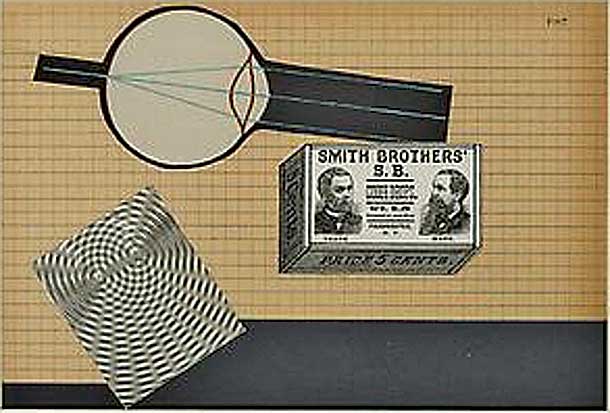Gold, garbage and biodiversity
Peter Thomashow’s collage “Smith Brothers Two”
Artists David Powell and Peter Thomashow discussed their collage series “Exposition of Matter & Magnetism: The Wonders of Science Revealed” at JSC on Nov. 6.
Their work, displayed in the Julian Memorial Gallery, is the first of three upcoming exhibitions that bring their wonders to Vermont and New York City.
Powell is a collector and associate professor of art at SUNY-Plattsburgh; Thomashow, a physician, collector and musician who teaches psychiatry at Dartmouth College School of Medicine.
The two met after Powell read the Cabinet Magazine article “The Old Curiosity Shop,” He tracked down Thomashow to inquire about early American electro-magnetic philosophical instruments.
The two learned that they had shared interest in the works of artists and sculptors Joseph Cornell and Marcel Duchamp, and that they both loved to collect strange and forgotten ephemera and objects.
The artists’ statement written in the galley is true in saying that their work encompasses a myriad of “mysteries and wonders,” including “childhood, electricity, space-time continuum, geometry, magnetism, human anatomy, thought experiments, carnival science, energy fields, natural history, tantric chakras, biodiversity, intelligent deign, camouflage, bottle caps, toys, confetti, color theory, sub-atomic particles, extra-sensory perception, magic, scientific method, [and] evolutionary theory.
“The Wonders of Science Revealed” highlights that science and art are parallel forms of inquiry.
Powell is more the type to visit dumps and dumpsters, sometimes striking out and sometimes finding gold.
Thomashow began collecting magnets at age seven. Over time, he became a collage artist, realizing that the simple arrangement of beautiful objects highlights their history and brings the past to life. He glues, nails, dowels and ropes his objects on wood, enclosed in glass, or in boxes that open to reveal the artistic innards.
His work adds a rustic third dimension to the exhibit.
One of his works displays pieces of an old metal toy train, still holding onto speckles the original paint. Another piece displays three dense, large paintbrushes under glass. Another is a collage of bottle caps; one displays an old set of original Crayola crayons.
My favorite Thomashow work is an assemblage within a two-framed box. On one side is a cutout of organs from an anatomy book. On the right side, Thomashow wove dozens of wires that mimic the color and shape of the exposed lungs, liver, kidney, and intestines.
“Nothing’s created in a vacuum,” said Powell. “If you’re sitting around wasting time waiting for the clouds to open up and reveal some secret of the universe to you, you’re going to be waiting a long time. Nothing is created from nothing. It’s a matter of making stuff. That’s what we do, we like to make stuff, it’s our work and play, and it’s fun.”
Director of the Julian Scott Gallery Leila Bandar spoke about an artist creating inventory for themselves. “These are pieces that you can’t do all at once. You have to go through the process of finding, collecting, assembling, contrasting, composing,” said Bandar. “You can almost feel the sense of time it takes, in both bodies of work.”
“For me, collage is almost purely recreational,” said Powell. “I never start with a blank canvas. That’s a frightening prospect- a blank page. [With collage] you always have stuff that your instantaneously react to. When making collage I think its best to let go of the rational mind and just react to what is at hand.”
Powell’s work incorporates poetic titles such as “Mechanical Golem,” “Rabbi Juria’s Quincunx Experiment,” “21st Century Schizoid Man,” “Communicating Vessels with Magnetic Fields,” and “Babel Power.”
My favorite work of Powell’s is a series of three prints called “Graphical Analysis of Intelligent Design,” “Extreme Theory A,” and “Extreme Theory B.” The first piece displays images scanned from an old book: a cat, an ape and a hunched, prehistoric looking man, all with red bones exposed through invisible skin, placed over a wavy matrix of red and black lines.
“Extreme Theory A,” shows the cat again, this time hanging on a poster in an apartment room that is deteriorating, where outer space can been seen through the windows and cracks. An alarm clock hides in the corner as a man with red bones duals his dual image, a dark self with blue bones that stands on the ceiling.
“Extreme Theory B” shows the prehistoric man again, this time drawing onto canvas the image of the ape portrayed in “Intelligent Design.” Others in the room include Cronos, the god of time, and his wife Rhea presenting him with what seems to be their offspring. In Powell’s words, the god of time is standing in place of the alarm clock that no longer exists in the room that floats in the stars.
Thomashow and Powell’s work will be in the galley through Nov. 29.
Travis LeClair joined the Basement Medicine staff in Spring 2014, assuming the position of staff reporter.






